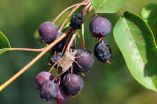JDR articles explore 3-D printing for oral and dental tissue engineering
2015-06-29
(Press-News.org) Alexandria, Va., USA - Today, the International and American Associations for Dental Research (IADR/AADR) published a case report on the first application of a 3D printed scaffold for periodontal tissue engineering in a human patient, along with a review of 3D printing for oral and craniofacial tissue engineering. These papers are published in the latest clinical supplement to the Journal of Dental Research, which encompasses all areas of clinical research in the dental, oral and craniofacial sciences, and brings emerging contributions in discovery and translational science to clinical application for the healthcare community.
In the case report titled "3D Printed Bioresorbable Scaffold for Periodontal Repair," researchers Giulio Rasperini, Sophia P. Pilipchuk, Colleen L. Flanagan, Chan Ho Park, Giorgio Pagni, Scott J. Hollister and William V. Giannobile provide the first reported human case of treatment of a large periodontal osseous defect with a 3D printed, bioresorbable, patient-specific, polymer scaffold and signaling growth factor. A patient diagnosed with severe destruction of periodontal tissues presented for treatment to preserve his dentition. The treated site remained intact for 12 months following therapy but failed at 13 months. Although this case was unsuccessful long term, the authors believe the approach warrants further study on how 3D printing can be implemented for the reconstruction of dental and craniofacial anomalies.
In a review titled "3D Bioprinting for Regenerative Dentistry and Craniofacial Tissue Engineering" reviewers Fabian Obregon, Cedryck Vaquette, Saso Ivanovski, Dietmar Hutmacher and Luiz Bertassoni describe different 3D bioprinting methods. They also summarize how different classes of biomaterials (polymers, hydrogels, ceramics, composites and cell-aggregates) may be utilized for 3D biomanufacturing of scaffolds, as well as craniofacial tissue analogues.
INFORMATION:
A companion podcast is also available for download. The papers and the companion podcast interview with Drs. Luiz Bertassoni and Scott J. Hollister are available online at http://jdr.sagepub.com. Reporters and writers may contact Ingrid L. Thomas at ithomas@iadr.org to request a PDF of the studies.
About the Journal of Dental Research
The IADR/AADR Journal of Dental Research, the journal for dental, oral and craniofacial research, is a multidisciplinary journal dedicated to the dissemination of new knowledge in all sciences relevant to dentistry and the oral cavity and associated structures in health and disease.
About the International Association for Dental Research
The International Association for Dental Research (IADR) is a nonprofit organization with more than 11,000 individual members worldwide, dedicated to: (1) advancing research and increasing knowledge for the improvement of oral health worldwide, (2) supporting and representing the oral health research community, and (3) facilitating the communication and application of research findings. To learn more, visit http://www.iadr.org. The American Association for Dental Research (AADR) is the largest Division of IADR, with nearly 3,400 members in the United States. To learn more, visit http://www.aadr.org.
ELSE PRESS RELEASES FROM THIS DATE:
2015-06-29
The goal for many cancer patients is to reach the five-year, disease-free mark, but new research from UR Medicine's Wilmot Cancer Institute suggests that two years might be a more practical survival goal for people with follicular lymphoma.
The difference underscores the fact that about 20 percent of follicular lymphoma patients consistently experience their disease coming back within two years of being treated with the latest therapies--despite the fact that most follicular lymphoma patients can expect to live 20 years.
People who relapse early may have a disease with ...
2015-06-29
NEW YORK (29 June 2015) -- There has been much recent discussion in the press of the plight of the so-called "sandwich generation," that is, adults who are responsible for the care of children as well as aging parents. The need for simultaneous childcare and eldercare is a reality that can limit families'--particularly women's--opportunities for paying work.
A new study by social scientists Emilio Zagheni and Denys Dukhovnov for the first time drills down into US statistics about who is providing this care, and who is receiving it. The study found that in 2012, adults ...
2015-06-29
WASHINGTON (June 29, 2015) -- As Liberia rebuilds a health care system decimated by the 2014 Ebola outbreak, understanding precisely how far citizens live from health facilities and its impact on seeking care can help shape new strategies to improve health care delivery and reduce geographic disparities.
A new examination of remoteness as a barrier to health care, published online today in the Journal of Global Health, notes that most surveys and policy documents categorize families as living either in an urban or rural setting, and this dichotomy can mask disparities ...
2015-06-29
When it comes to the art of persuasion, you can attract more followers if you turn conventional wisdom on its head and stress what you like, not what you do.
A new study, to be published in an upcoming issue of the Journal of Personality and Social Psychology, finds that people are more likely to conform to others' preferences than conform to others' actions. In other words, people want to like what others like, but they want to have or do what others don't have or don't do.
In the study, "Words Speak Louder: Conforming to Preferences More Than Actions," by University ...
2015-06-29
DURHAM, N.C. - Researchers at Duke University School of Medicine and Brigham and Women's Hospital, Harvard Medical School have identified a mechanism that explains why some mutations can be disease-causing in one genome but benign in another.
In a study appearing June 29, 2015, in the journal Nature, the researchers compared thousands of human disease-causing mutations with the analogous sequences of some 100 animal species. They discovered non-human genomes carrying mutations that cause severe disease in humans, yet were benign in the animals.
Although generally in ...
2015-06-29
The brown marmorated stink bug has a bad reputation. And for good reason: every summer, this pest attacks crops and invades homes, causing both sizable economic losses and a messy, smelly nuisance--especially in the eastern United States. A new study by entomologists at the University of Maryland shows that these pests, known simply as stink bugs, have a strong preference for ripe fruit. Moreover, stink bugs track their favorite fruits throughout the growing season in an effort to maximize their access to food.
The study, published online June 25, 2015 in the Journal ...
2015-06-29
PHILADELPHIA -- Since their discovery in the 1950s, transfer RNAs (tRNAs) have been best known for their role in helping the cell make proteins from messenger RNA templates. However, recent studies have led to a previously-unsuspected concept that tRNAs are not always the end product; namely, they further serve as a source of small RNAs. Now researchers have discovered a new species of tRNA-derived small RNAs that are produced only in hormonally-driven breast and prostate cancers, and which contribute to cell proliferation. The results will be published online the week ...
2015-06-29
The warm temperature on a summer's day is often a time for relaxing, but researchers from the University of Leicester have suggested that a 'thermosensory' gene could be responsible for changes in behaviour in different climates.
The researchers from the University of Leicester's Department of Genetics have explored how the biological clock can be affected by the environment by examining the fruitfly Drosophila melanogaster, which shows 24 hour biological cycles and is used as a model organism for studies into human rhythms.
Like many humans, the fly has a 'siesta' ...
2015-06-29
It's been difficult to explain patterns of toxic mercury in some parts of the world, such as why there's so much of the toxin deposited into ecosystems from the air in the southeastern United States, even upwind of usual sources.
A new analysis led by researchers at the University of Colorado Boulder shows that one key to understanding mercury's strange behavior may be the unexpected reactivity of naturally occurring halogen compounds from the ocean.
"Atmospheric chemistry involving bromine and iodine is turning out to be much more vigorous than we expected," said ...
2015-06-29
A University of Oklahoma professor studying malaria mosquito interaction has discovered a new mosquito protein for the development of a new vaccine that is expected to stop the spread of the disease in areas where it is considered endemic. Malaria is transmitted by mosquitoes, and it infects millions of people in Africa, Asia and South America every year, causing a global health crisis. In addition to the local populations, U.S. military personnel stationed in these areas and travelers to these malaria-prone areas are at risk of becoming infected.
Jun Li, assistant ...
LAST 30 PRESS RELEASES:
[Press-News.org] JDR articles explore 3-D printing for oral and dental tissue engineering

